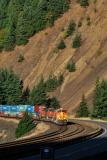
| Home | Open Account | Help | 354 users online |
|
Member Login
Discussion
Media SharingHostingLibrarySite Info |
Western Railroad Discussion > Traffic Patterns Change Over TimeDate: 10/24/09 19:55 Traffic Patterns Change Over Time Author: JDRumley Photo #1 East and west bound freights meet at Cooks, WA. April 9, 1977
Photo #2 eastbound double stack passes through cooks. September 22, 2009 Contrary to the comparison between these two photos, traffic has greatly increased on the water level route in between Pasco and Vancouver Washington. I do not have any actual numbers, but just from my personal observations I would venture a guess that traffic has increased three to four times what it was in the late '70s. Back then you could wait three to four hours in between trains, now traffic can be nearly continuous at times. Two to four east bounds can leap frog from siding to siding against an equal number of west bounds, and this can go on any time of the day or night. The type of traffic has also changed considerably. Box car manifests and a couple of pig trains in the early days of the Burlington Northern have transitioned into double stack intermodal and unit grain trains making up the greater percentage of BNSF traffic today. There still exists a reasonable amount of box car traffic and and the occasional unit export coal train as well. Gone are the Alco Centuries and RS's, EMD F's and first generation GP's, SD and F45's, U-boats, and even the venerable SD40-2's are a rarity any more. The backbone of BNSF's fleet of today are the GE -9's and EMD SD60/70's and their variants. Distributed power is nearly standard practice now for unit trains here as well as being used on many Inside Gateway manifests. Where will it go from here?   |